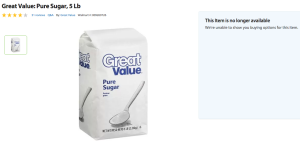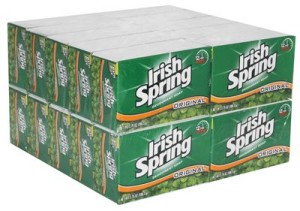Beware of Subliminal Inflation
Are you getting less for the same price?
Listen to this episode on iTunes or Stitcher, or in the player below:
For Above Average we have lots of show ideas, and many of them are money related: debt, savings, budgeting, etc. We’ll get there someday!
But for Punch Out (our short episode format) this week, I wanted to make sure you’re aware of one increasingly popular way our families get less than we bargain for. After all, big families buy more, so when we get shortchanged our budgets are impacted more. We touched on this in Episode 20 with our guest Jenny Martin of SouthernSavers.com, but we’re going to dig deeper this week.
Subliminal Inflation
Have you heard of “subliminal inflation”?
It’s when a product essentially increases its price without the actual price tag changing. And even if you’re not familiar with the term, you’ve probably seen the consequences: you just feel a little more shortchanged when you get to the bottom of the cereal box, thinking, “I could have sworn the last box of Cheerios lasted longer…” It’s usually subtle.
The way this used to happen – and still does in some cases – is that the price of an item would just go up. The standard 5 pound bag of sugar that used to cost $2.50, now costs $2.75. Simple, right? Of course no one likes to see prices go up, but at least this way the price change is visible, clear, and measurable.
Subliminal inflation is different. It’s sneaky. And as the name implies, you may not even realize it. But we’re here to change that!
Recent examples of subliminal inflation:
- Spaghetti O’s cut the can sizes from 15 ounces to 14 ounces.

5 pound bag? No longer available.
- McCormick pepper went from 4 ounces to 3 ounces. That’s a huge decrease, and it’s not like they dropped the price at all. To make matters worse, they kept the same package size, but just filled it with less pepper.
- Bacon. For the most part, bacon used to come in a 1 pound package (16 ounces). Now many brands are 12 ounces.
- Store-made cookie packages used to have 16 cookies, but now have 12 for the same price.
- If the packaging looks the same, notice that the bottom of the pack now has an slope, an angle, that lets fewer cookies look like more.
- Coca-Cola’s new “35 Pack”
- If you’re from my generation, you’re probably expecting your soft drinks to come in 6, 12, and 24 packs. What’s up with a 35 pack? You can bet this increased the per-can price.
- Let’s do the math: The price for the 35 pack was $10.98. Break this down, and you get 31.4 cents per can, which translates into $3.77 per 12 pack. Not a very good deal at all.
- Even Dollar General recently had a sale on 3 12-packs for $9.
- And that standard 5 pound bag of sugar mentioned earlier? It’s not standard anymore – it’s now a 4 pound bag in almost all cases.
It’s not just food

Irish Spring – Now with less Irish Spring!
Besides food, almost all personal items like soap and deodorant are going through this change. Keep this rule of thumb: if it’s not a fresh item and it’s at the grocery store, you should expect subliminal inflation.
For instance, Irish Spring has downsized over the years by keeping the same box and number of bars in a package, but actually making the bar more “contoured” – translation: the product weight has been cut substantially. Moreover, Irish Spring is owned by Colgate, so if they’re inflating soap costs, you can bet they’re doing the same thing with their other brands like their toothpastes, and even Murphy’s Oil Soap.
This is something the national brands and discount stores are all doing. It’s an industry-wide trend, so you can expect everyone involved to play the game.
Procter and Gamble, who make hundreds of products like Charmin, Bounty, and Dawn soap, are doing this right alongside the exclusive brands Aldi and Dollar Tree sell. Aldi recently decreased the size their premium bread packages, and Dollar Tree lowered the quantity of nacho cheese sauce.
How to notice subliminal inflation
This kind of price inflation happens most often when a new package comes out. The package may say something like “2 ounces extra for free!” But really, it’s the same old 16 ounce size transitioning to a new 14 ounces. Next thing you know, instead of getting 14 + 2 ounces (the old 16 ounce pack), you’ll only be getting 14 ounces.
However, sometimes the size doesn’t change, and the price doesn’t change. But you’re still getting less for the same amount. How? Ingredient swaps.
One example – and in thousands of cases – is that real sugar has been replaced with High Fructose Corn Syrup. If you’re one of those “natural living” people, you’ve surely noticed this on the health side – there’s been a big pushback again HFCS in recent years. The reason that manufacturers have made the swap is money: corn syrup is about 25-30% cheaper than beet sugar.
What to do about it
- Be aware. Don’t just assume that all brands, packages, and products are created equally. Before you go shopping, be mindful of subliminal inflation. And once you’re there, don’t get excited about faux-perks like “2 ounces free!”
- Pay attention to the unit price, usually the “per ounce” cost. One thing we love about shopping at Kroger (and I’m sure they’re not the only ones who do this), is that they clearly list the unit price on the store shelves, even for discount items. This allows you to easily do the math on the real cost of what you’re buying.
- Try store brands and value brands. This isn’t as much of a tactic as it is somewhat of a lifestyle change, but if you need to pinch pennies, this is one great way to do it. Start with something basic like cereal. Can your kids tell the difference between Fruit Loops and Tootie Frooties? Mine can’t. Caveat: It’s not a perfect tactic – some value brand items like diapers haven’t worked out for us. But it’s worth trying, especially with there’s a guarantee attached. (Thanks Aldi!)
- Use less of this stuff. In the case of food, buy more fresh food! Until scientists learn how to screw up the banana, the only way they can get more money for produce is to simply charge more. This may not save you money. It may even cost a little more. But it seems like most of the items that are affected by subliminal inflation aren’t very healthy, certainly compared to fresh food.
Beat the system
Personally, I’d rather have the same exact amount and just pay the higher price. I think most budget-conscious people would! That’s what we see with items like butter and milk that have government regulations attached to their pricing.
But brands and the corporations behind them are smart – they know that generally consumers won’t notice the subliminal inflation and therefore won’t change their habits.
Now that you’re aware of the game, you’ll be able to beat them at it!
Resources:
Subscribe to the show on iTunes or listen on Stitcher.
Photo credits: Old grocery store, Public Domain; Sugar, walmart.com

